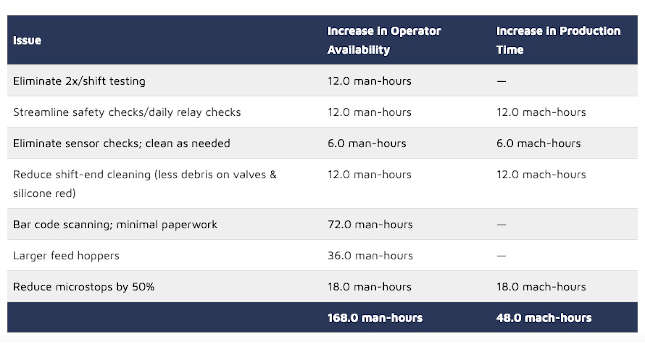Using data analysis to find out what the dominant products within a facility are and the processes used to create them and how they flow within a plant facility is a useful way to make a company Leaner.

Total productive maintenance, six sigma, set-up reduction, or 5S methods may be used either separately or together to help a facility’s team define the best path to a Lean goal. However, there is another approach to Lean, which starts with data analysis and ends with strategic planning.
This approach forces companies to ask, "What are the dominant products that are produced in the company? How similar are the processes used to create them? How well do they currently flow together within the facility?"
To best answer these questions, consider using three Lean tools from the Toyota Production System: The spaghetti chart, product quantity analysis (PQA), and the process matrix.
Taking an existing plant layout and drawing the path that a product takes as it moves through the facility creates the spaghetti chart. If each product is drawn with a different color, the spaghetti chart will reveal criss-crosses, repeat trips, and reversals in flow. It will also reveal how well the processes of different products are aligned.
A well-executed PQ analysis helps companies see the highest to lowest demand for all products produced within a facility. To do a PQA, graph the total quantity of products over a timeframe (six months to a year) on the y1 axis of a chart, with the cumulative percentage of the total products on the y2 axis of the same chart.
This exercise typically reveals the 80/20 rule, where approximately 80% of production volume exists in 20% of the products.
To optimize floor space, equipment, and manpower, it needs to be determined if the top 80% of products can flow down the same production line, which is where the process matrix, which categorizes product families, comes in.
To create the process matrix, use a spreadsheet. Each unique product is identified in the first column. Beginning with the product that has the highest volume, (as identified within the PQA) each process step is identified in each of the subsequent columns.
Under each process step, a number is placed in the box indicating which step it occurs in the process. These numerical steps should match what is on the process routers (as well as on the spaghetti chart). Together, the spreadsheet and spaghetti chart serve as a complete data set that tell a full story of what is happening.
Add each product to the spreadsheet in subsequent rows from left to right. It is important not to go backwards in the rows with numbering to a process that was utilized by another product in an earlier step. Instead, a new column is inserted and that same process step identifier is written at the top. The goal is to ensure that every product flows from left to right in numerical order without any reversals.
Once this is complete for every unique product in the cell, it should be printed out and reviewed with the team. The cross-functional team will then review the process matrix and spreadsheet to pinpoint where the process is not aligned, i.e., where process steps are occurring at different times for each product requiring duplicate processes. The goal is to see if the process can be re-engineered to align work at the same time for each product. Where this is not possible, a duplicate workstation may be required.
Work should progress through the line with no reversals. Once the matrix is fully re-engineered and complete, the team reviews all products and notices the ones that share common steps.
By definition, a product family should follow the 80/30 rule: 80% of the processes are common across all products in a product family and the work content total for each product does not vary more than 30% between the products in the product family. Every product that meets these requirements can be considered part of the same product family and should be produced in the same production line.
With this full set of data completed, the team will have a full understanding of where to focus their improvement efforts. The team working with the leadership team can then set a strategic plan. Typical plans will implement flow lines where feasible (line improvement), followed by kaizen events to address bottlenecks identified by inventory accumulation, long lead times or subsequent data analysis (point improvement).
Nicole N. Snurkowski is a lead consultant and associate for Daniel Penn Associates, LLC (DPALLC) with more than 25 years of experience in Lean system management in the areas of aerospace development, manufacturing, operations, and supply chain. This article originally appeared on Daniel Penn Associates’ Blog. Daniel Penn Associates is a CFE Media content partner.



